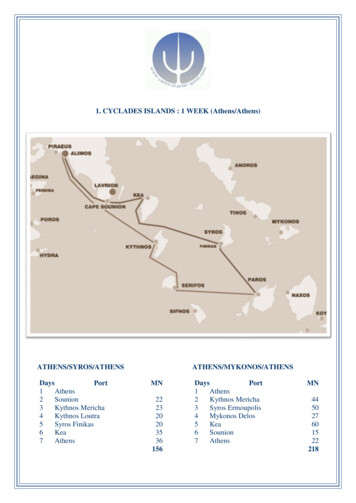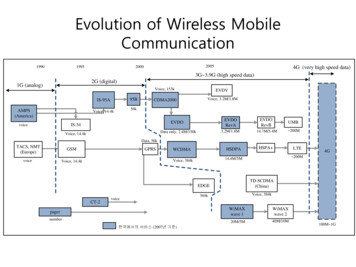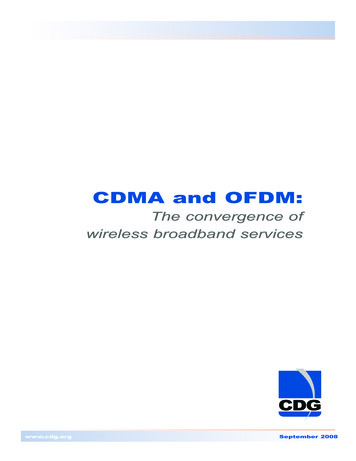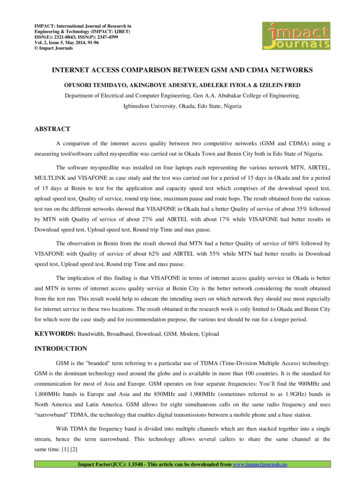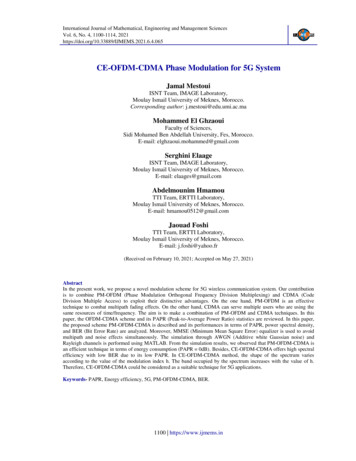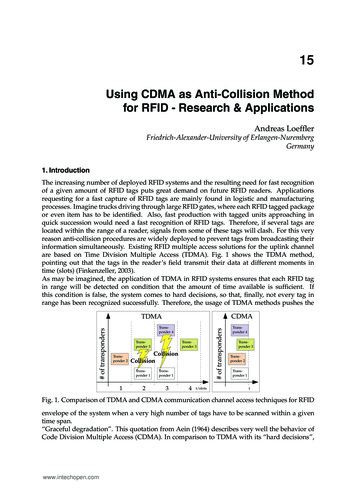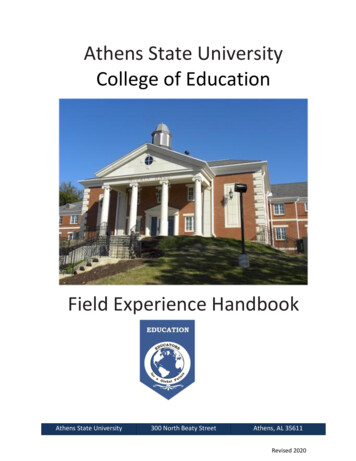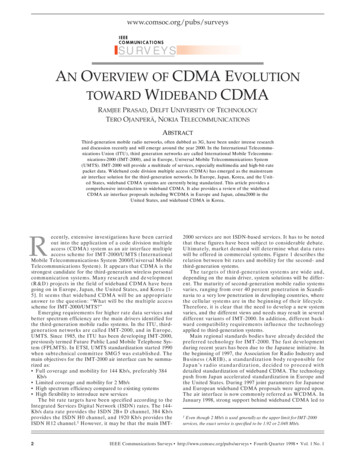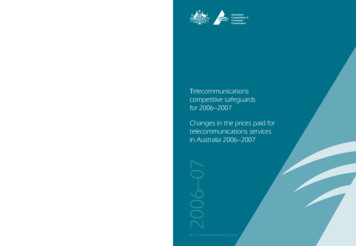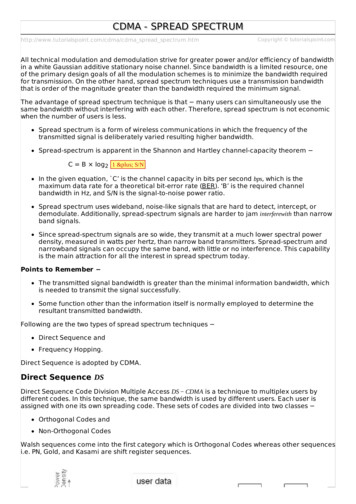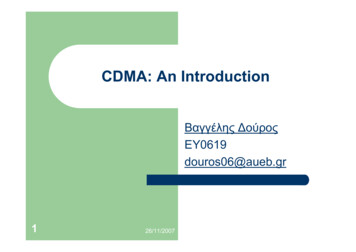
Transcription
CDMA: An IntroductionΒαγγέλης ΔούροςEY0619douros06@aueb.gr126/11/2007
Motivationzzz2Why do we need CDMA?Which are its basic principles?What do we earn by using it?
Outlinezzzzzz3IntroductionCDMA BasicsCDMA DeeperCDMA ProblemsCDMA BenefitsConclusions
Why Multiple Access?zzGoal: Multiple use of ashared medium.Multiplex channels inthree dimensions:–––4Time (t)Frequency (f)Code (c)
Frequency Division Multiple Access(FDMA)zzzz5Cocktail Party Analogy: Peoplecreate teams and discuss. Thereis a distance among them.(-) Requires guard bandbetween channels(-) Waste of bandwidth if traffic isdistributed unevenlyExample: broadcast radio
Time Division Multiple Access (TDMA)zz6Cocktail Party Analogy:People have access to thesame room but each ofthem waits for his turn tospeak.(-) Precise synchronizationnecessary
Time and Frequency Division MultipleAccesszz7(-) Precise coordinationrequiredExample: GSM
Code Division Multiple Access (CDMA)zz8Cocktail Party Analogy:All people are in the sameroom together. They canall be talking the sametime!Example: UMTS
Spread SpectrumzzPN: Pseudo-Noise code sequence Æ spread/despread the signal.Modulation:––FSK ÆFrequency hopped (FH) multiple access)PSK ÆDirect sequence (DS) multiple access)D9mD
FHMAzzzzz10Bandwidth divides in non overlapping bands.Signal shifts from band to band in predefinedintervals.Receiver is synchronized with the transmitter( ) less interferenceUse: Bluetooth
CDMA Basics (1)zzzzzEach station is assigned a unique m-bit code (chip sequence)To send bit 1, station sends chip sequence.To send bit 0, station sends the complement.Example: 1 MHz band with 100 stations.FDMA––zCDMA––11Each station a 10kHz bandRate:10 kbps (Assume that you can send 1bit/Hz)Each station uses the whole 1MHz bandÆ106 cps.If 100 chips per bitÆ Rate 10 kbps
CDMA Basics (2)zLetzCompare any pair of these sequencesvectors Multiply any pair of these sequencesvectors Two chips S,T are orthogonal IFF S T 0zzzor1 mS T SiTi 0m i 1111S S S S S ( 1)mmmm12i 1miii 1 S T 0 S T 0m2ii 12mm11 1 S S Si S i ( 1) 1 ( m) 1m i 1m i 1m
CDMA Basics (3)zLet A, B, C, D transmit correspondingly bit 1,0,1, .zAssume that:–––zz13All stations are perfectly synchronous.All codes are pair wise orthogonal (aren’t they?).If two or more stations transmit simultaneously, the bipolar signalsadd up linearly.Receiver “understands” S A B C ( 1 1 3 3 1 1 1 1)How can the receiver “understand” what bit station C send?
CDMA Basics (4)zLet’s compute the normalized inner product S C1S C ( 1 1 -3 3 1 -1 -1 1) (-1 1 -1 1 1 1 -1 -1) 811 (1 1 3 3 1 1 1 1) 8 188zzRight!By accident? S C ( A B C ) C A C B C C C 0 0 1 1z14Remember: All codes are pair wise orthogonal!
CDMA Basics (5)zzzReverse way Think that each chip sequence arrives separatelyReceiver separately computes each inner productA C 0 (1) B C 0 (2)C C 1 (3)S 0 0 1 1z15It keeps only the non-orthogonal pair, i.e. the right bit
CDMA Deeper (1)zzMore advanced analysis Sender:sd (t ) A cos(2π f c t θ (t ))θ (t ) {0, π }c(t ) { 1, 1}s (t ) A cos(2π f c t θ (t ))c(t )zReceiver:s (t )c(t ) A cos(2π f c t θ (t ))c(t )c(t ) A cos(2π f c t θ (t )) sd (t )16
CDMA Deeper (2)zzzzzWith orthogonal codes, we can safely decode thecoding signals.Noise?R’ R N, N: m-digit noise vector and N ( a a a)Decode R' S (R N) S S S (orthogonal codes) S N S 1 0 ?No problem if chipping codes are balanced (same )R' S (R N) S S S (orthogonal codes) S N S 1 0 (a a a a)( 1 1-1-1) 1 0 0 117
CDMA Deeper (3)zzzzHow many codes can we construct with m chips?m (why?)If m 2k, Walsh-Hadamard codes can beconstructed recursively!The set of codes of length 1 is C { }For each code c Ck we have two codes { c c c c } CCode Tree:0zzzC0 { }C1 { , }C2 { , - - , - - , - - }18k 1
CDMA Deeper (4)zzzzz19Correlation: Determines similarity between two sets of data.– Possible valuesz 1 sequences are similarz 0 no relationship between them.z -1 one is the mirror of the otherCross correlation: Compare two sequences from differentsourcesAuto correlation: Compare a sequence with itself after a timeintervalWalsh Codes: No cross correlation – Low auto correlationPN sequences: Low cross correlation – Low auto Correlation
CDMA Deeper (5)zzzWe cannot have more than m orthogonal codes.Let m k stations and m chips Idea: Use PN Sequences.R S S S (k random codes) S (m-1 orhogonal codes) S z 1 ? 0zzz20?: the sum of the k random variables that are either 1 or -1.But PN Sequences low cross correlation. ? should be 0.Experimental evaluation: For k m 128, decoding is correctmore than 80%.
CDMA Problems (1)zAll stations are received with the same power level zIn reality users may be received with very different powers!Near-far ProblemSolutions:zz––Empirical rule: Each MS transmits with the reverse power that itreceives from the BSPower Control!zz21Open LoopFast Closed Loop
CDMA Problems (2)zzzzzz22Bad Properties of Walsh CodesPerfect Synchronization of allusers required.Impossible is nothing! Use a longenough known chip sequence.But In a multipath channel,delayed copies may bereceived, which are notorthogonal any longer.Self-Interference.
CDMA Problems (3)zzzzzzz23So far (-)tight synchronization(-)self-interference(-)Near-far problem(-)Higher complexity of sender/ receiver How did Qualcomm convince people to usethis stuff?
CDMA Benefits (1)z24Unlike FDMA and TDMA, CDMA does not rely onorthogonal frequency and time slots!
CDMA Benefits (2)zIn TDMA and FDMA systems––zIn CDMA systems––25Nothing to sendÆ time/frequency slot is wastedDynamic allocation is very difficultNothing to sendÆ less interferenceTransmit half timesÆ doubles the capacity
CDMA Benefits (3)zz26FDMA-TDMA use sectors to decrease the reusedistanceCDMA use sectors to increase capacity (triple it)!
CDMA Benefits (4)zzWhy handoff?Types––27“Hard”“Soft”
CDMA Benefits (5)Hard Handoffzzz28Break-Before-MakeEach MScommunicates with onlyone BS each time( )Reduced droppedcalls
CDMA Benefits (6)zzzz29Each MScommunicates withmore than one BS eachtimeUse Signal Strength todecide where toconnect.Make-Before-Break( ) no dropped callsSoft Handoff
CDMA Benefits (7)zzzzzz30Capacity TDMA-FDMA: bandwidth limitedCDMA: interference limitedCDMA’s capacity is bigger.How?Long Story
ConclusionszzBack to the start Why do we need CDMA?–zWhich are its basic principles?––zCDMA BasicsCDMA DeeperWhat do we earn by using it?––31IntroductionCDMA ProblemsCDMA Benefits
Ευχαριστώ!32
CDMA Basics (1) z Each station is assigned a unique m-bit code (chip sequence) z To send bit 1, station sends chip sequence. z To send bit 0, station sends the complement. z Example: 1 MHz band with 100 stations. z FDMA - Each station a 10kHz band - Rate:10 kbps (Assume that you can send 1bit/Hz) z CDMA - Each station uses the whole 1MHz .
